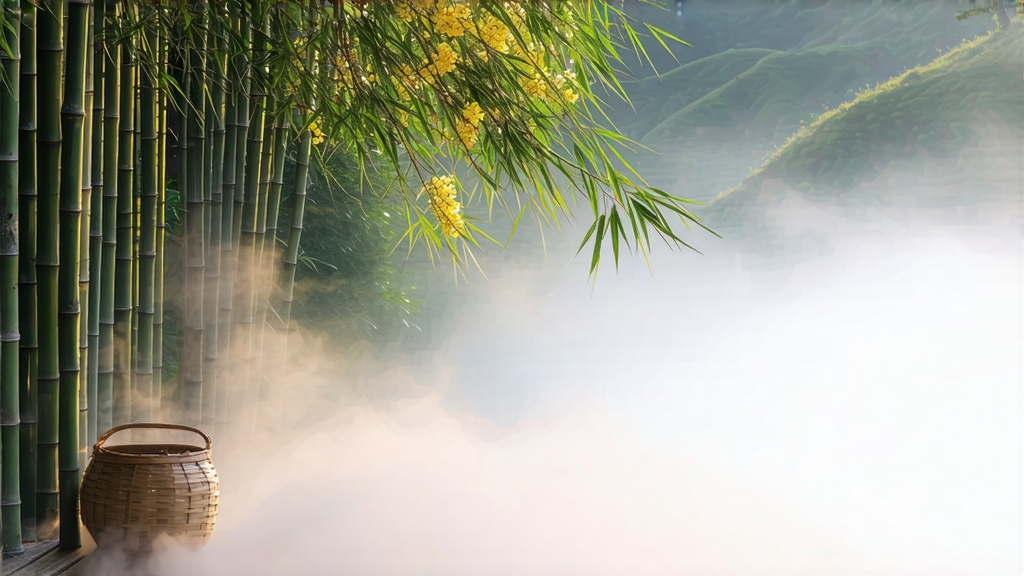
Tucked high on the mist-locked peaks of Sichuan’s Meng Ding mountain, where clouds brush the bamboo canopy and the Min River glints far below, one of China’s most discreet treasures has been quietly turning golden for twelve centuries. Meng Ding Huang Ya—literally “Meng Ding Yellow Bud”—is the aristocrat of yellow teas, yet its fame has long been eclipsed outside China by the green teas grown on the same slopes. This article invites the international tea lover to step past the veil of fog and legend, to meet a tea whose very colour tells the story of an extra, secret breath given to the leaf.
A leaf born of poetry and empire
The first written record appears in a Tang-dynasty stele dated 808 CE: the monk Gan Lu, “Sweet Dew,” plants tea on Meng Ding’s summit and presents the spring buds to the emperor. By the Song dynasty the buds are so coveted that court officials ride the postal relay day and night to deliver them fresh; the road becomes known as the “Imperial Bud Path.” When the Ming emperor abolished compressed tribute cakes in 1391, loose Meng Ding Huang Ya became one of only seven teas permitted to enter the Forbidden City. Poets compared its liquor to “first light on palace silk,” and dowager empresses hoarded it for the aroma that “makes the sleeve fragrant three days after pouring.” Yet after the fall of the Qing, production lapsed; the craft survived only in the memory of a handful of hereditary tea farmers. It was not until 1959 that the Sichuan Tea Research Institute, tracing ancient kiln foundations under wild kiwi vines, re-established the original cultivar and technique. Today fewer than 3 000 kg of authentic Meng Ding Huang Ya reach the market each year, most pre-sold to collectors in Beijing and Shanghai.
The micro-world of a single bud
Meng Ding mountain rises abruptly from the Sichuan basin, catching monsoon moisture that condenses into a 280-day fog belt. UV-B light is filtered, so the tea bush (a local clone of Camellia sinensis var. sinensis known as “Shu Ye Zao”) compensates by manufacturing more amino acids—especially theanine—than almost any other Chinese tea. Spring nights can drop to 8 °C while midday touches 24 °C; the diurnal swing tightens the cell walls, concentrating aromatic precursors. The bud itself is picked when it is barely 15 mm long, still shielded by a fish-scale of downy cataphylls that will later turn lemon-yellow during the “sealed yellowing” step. One kilogram of finished tea demands between 48 000 and 52 000 such buds, all plucked before the Qingming festival when the mountain azaleas have not yet opened.
Craft: the art of letting the leaf suffocate gently
Yellow tea is often mis-described as “green tea with an extra pan-firing.” In reality the hallmark is men huang—controlled, non-enzymatic oxidation inside a humid bundle. Meng Ding Huang Ya undergoes three successive rounds of firing, wrapping and suffocation, each cycle lowering the leaf’s moisture by about 5 % while allowing Maillard reactions to tint the chlorophyll into shades of olive and antique gold.
-
Kill-green with bamboo
Within fifteen minutes of plucking the buds are slid into a shallow wok heated by burning local bamboo. The temperature is held at 140 °C for exactly 180 seconds; the artisan uses only the heel of her palm to avoid breaking the bud tip. Enzymes are denatured, yet the leaf retains 55 % moisture—higher than green tea—setting the stage for yellowing. -
First wrapping—“the hot pillow”
The wilted buds are immediately piled in a linen pouch only half full; the mouth is cinched loosely so steam can escape. The pouch rests on a hemp-filled bamboo tray at 34 °C and 75 % RH for 40 minutes. During this nap the leaf turns noticeably yellower and develops a scent of steamed pumpkin and wet slate. -
Second firing & re-wrapping
A gentler 80 °C wok pass reduces moisture to 45 %. The leaf is now rolled for the first and only time—just enough to bruise the epidermis without fracturing it—then wrapped again, this time in thick yellow cotton, and left overnight. Micro-fermentation: sugars migrate, amino acids condense, and a thin film of aromatic ketones